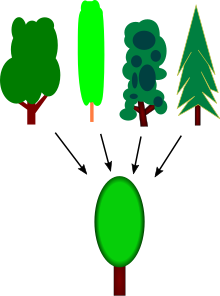Generalization
A generalization is a form of
Generalization can also be used to refer to the process of identifying the parts of a whole, as belonging to the whole. The parts, which might be unrelated when left on their own, may be brought together as a group, hence belonging to the whole by establishing a common relation between them.
However, the parts cannot be generalized into a whole—until a common relation is established among all parts. This does not mean that the parts are unrelated, only that no common relation has been established yet for the generalization.
The concept of generalization has broad application in many connected disciplines, and might sometimes have a more specific meaning in a specialized context (e.g. generalization in psychology, generalization in learning).[1]
In general, given two related concepts A and B, A is a "generalization" of B (equiv., B is a special case of A) if and only if both of the following hold:
- Every instance of concept B is also an instance of concept A.
- There are instances of concept A which are not instances of concept B.
For example, the concept animal is a generalization of the concept bird, since every bird is an animal, but not all animals are birds (dogs, for instance). For more, see
Hypernym and hyponym
The connection of generalization to specialization (or
Examples
Biological generalization

An animal is a generalization of a mammal, a bird, a fish, an amphibian and a reptile.
Cartographic generalization of geo-spatial data
Generalization has a long history in
Generalization is meant to be context-specific. That is to say, correctly generalized maps are those that emphasize the most important map elements, while still representing the world in the most faithful and recognizable way. The level of detail and importance in what is remaining on the map must outweigh the insignificance of items that were generalized—so as to preserve the distinguishing characteristics of what makes the map useful and important.
Mathematical generalizations
- A polygon is a generalization of a 3-sided triangle, a 4-sided quadrilateral, and so on to n sides.
- A hypercube is a generalization of a 2-dimensional square, a 3-dimensional cube, and so on to n dimensions.
- A to higher dimensions.
- A MacLaurin series.
- The binomial formulais a generalization of the formula for .
See also
- Categorical imperative (ethical generalization)
- Ceteris paribus
- Class diagram § Generalization/Inheritance
- External validity (scientific studies)
- Faulty generalization
- Generic (disambiguation)
- Critical thinking
- Generic antecedent
- Hasty generalization
- Inheritance (object-oriented programming)
- Mutatis mutandis
- -onym
- Ramer–Douglas–Peucker algorithm
- Semantic compression
- Inventor's paradox
References
- ^ a b "Definition of generalization | Dictionary.com". www.dictionary.com. Retrieved 30 November 2019.
- ^ Nordquist, Richard. "Definition and Examples of Hypernyms in English". ThoughtCo. Retrieved 30 November 2019.
- ^ "Scale and Generalization". Axis Maps. 14 October 2019. Retrieved 30 November 2019.

